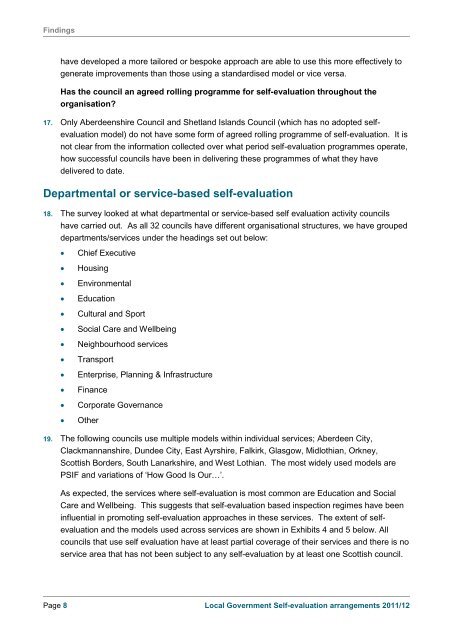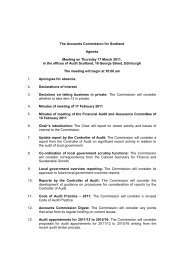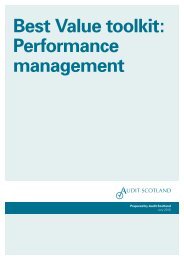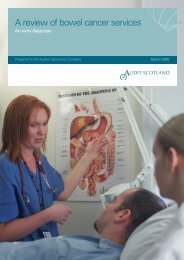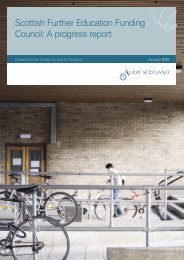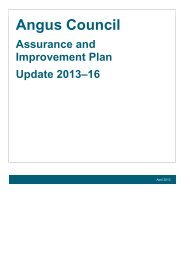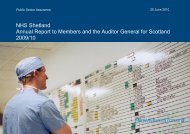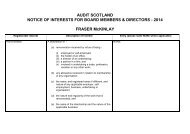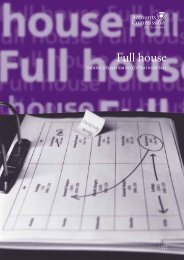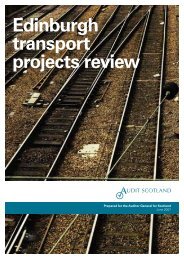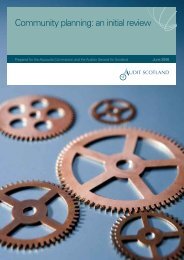Local Government self-evaluation arrangements ... - Audit Scotland
Local Government self-evaluation arrangements ... - Audit Scotland
Local Government self-evaluation arrangements ... - Audit Scotland
You also want an ePaper? Increase the reach of your titles
YUMPU automatically turns print PDFs into web optimized ePapers that Google loves.
Findingshave developed a more tailored or bespoke approach are able to use this more effectively togenerate improvements than those using a standardised model or vice versa.Has the council an agreed rolling programme for <strong>self</strong>-<strong>evaluation</strong> throughout theorganisation?17. Only Aberdeenshire Council and Shetland Islands Council (which has no adopted <strong>self</strong><strong>evaluation</strong>model) do not have some form of agreed rolling programme of <strong>self</strong>-<strong>evaluation</strong>. It isnot clear from the information collected over what period <strong>self</strong>-<strong>evaluation</strong> programmes operate,how successful councils have been in delivering these programmes of what they havedelivered to date.Departmental or service-based <strong>self</strong>-<strong>evaluation</strong>18. The survey looked at what departmental or service-based <strong>self</strong> <strong>evaluation</strong> activity councilshave carried out. As all 32 councils have different organisational structures, we have groupeddepartments/services under the headings set out below:Chief ExecutiveHousingEnvironmentalEducationCultural and SportSocial Care and WellbeingNeighbourhood servicesTransportEnterprise, Planning & InfrastructureFinanceCorporate GovernanceOther19. The following councils use multiple models within individual services; Aberdeen City,Clackmannanshire, Dundee City, East Ayrshire, Falkirk, Glasgow, Midlothian, Orkney,Scottish Borders, South Lanarkshire, and West Lothian. The most widely used models arePSIF and variations of ‘How Good Is Our…’.As expected, the services where <strong>self</strong>-<strong>evaluation</strong> is most common are Education and SocialCare and Wellbeing. This suggests that <strong>self</strong>-<strong>evaluation</strong> based inspection regimes have beeninfluential in promoting <strong>self</strong>-<strong>evaluation</strong> approaches in these services. The extent of <strong>self</strong><strong>evaluation</strong>and the models used across services are shown in Exhibits 4 and 5 below. Allcouncils that use <strong>self</strong> <strong>evaluation</strong> have at least partial coverage of their services and there is noservice area that has not been subject to any <strong>self</strong>-<strong>evaluation</strong> by at least one Scottish council.Page 8 <strong>Local</strong> <strong>Government</strong> Self-<strong>evaluation</strong> <strong>arrangements</strong> 2011/12


